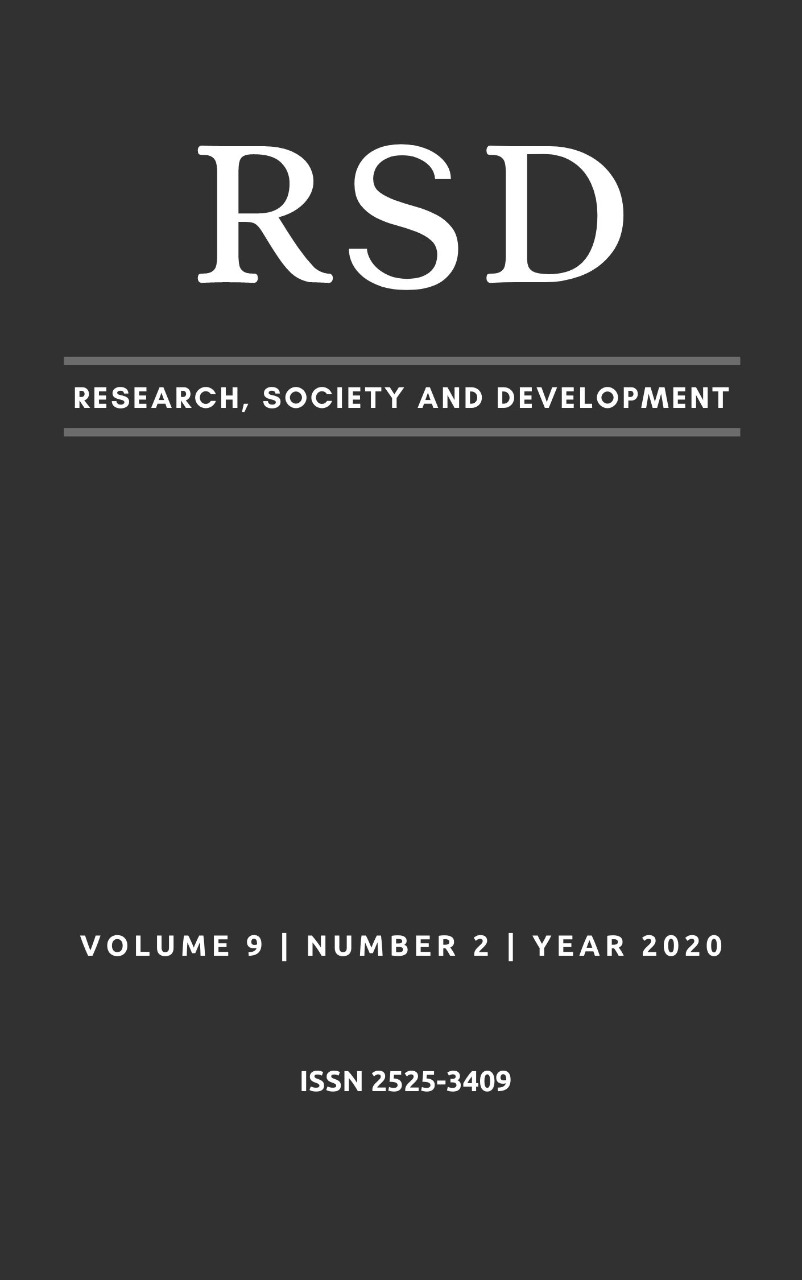Risk factors for hyperglycemia in kidney transplant patients
DOI:
https://doi.org/10.33448/rsd-v9i2.2143Keywords:
Kidney transplantation, Nutritional status, Blood glucose, Nutritional assessment,Abstract
The aim of this study was to analyze the risk factors associated with hyperglycemia in renal transplant patients. For this, a retrospective cross-sectional study was conducted to collect clinical, laboratory and anthropometric data from patients who underwent kidney transplantation. To identify factors associated with hyperglycemia, a bivariate and multivariate analysis was performed with hierarchical models. Among the 89 patients evaluated, the body mass index revealed 47.1% of eutrophic patients and 34.7% overweight. 28% of the patients had hyperglycemia and 82%, 86.5%, 87.6% and 91% had altered creatinine, urea, hemoglobin, and hematocrit, respectively. A statistically significant association (p <0.05) of hyperglycemia with obesity II and III was found, and patients with obesity II and III were more likely to have altered glycemia and potassium, (PR = 4.91; CI: 1.04, p <0.001; RP = 2.23; CI: 1.09-4.54, p = 0.026), respectively. Obesity and hyperkalemia were found to be risk factors for hyperglycemia in renal transplant patients.
Downloads
References
Aksoy, N. (2016). Weight gain after kideney transplant. Exp Clin Transplant. 14(Suppl 3):138-140.
Associação Brasileira de Transplante de Órgãos (ABTO). (2018). Registro Brasileiro de Transplantes. Dimensionamento dos Transplantes no Brasil e em cada Estado. Ano XXIV, n.4.
Associação Brasileira para o Estudo da Obesidade e da Síndrome Metabólica - ABESO. (2016). Diretrizes Brasileiras de Obesidade. 4ª Ed. São Paulo: ABESO.
Blackburn, G. L., Thornton, P. A. (1979). Nutritional assessment of the hospitalized patient. Med Clin North Am. 63(5):11103-15.
Brasil. (2011). Ministério da Saúde. Orientações para a coleta e análise de dados antropométricos em serviços de saúde: Norma Técnica do Sistema de Vigilância Alimentar e Nutricional – SISVAN. Brasília, Ministério da Saúde.
Calixto-Lima, L., Gonzales, M. C. (2018). Nutrição Clínica no dia a dia. 2ª ed. Rio de Janeiro: Rubio.
Claudino, L. M., de Souza, T. F., Mezzomo, T. R. (2018). Relação entre eficiência da hemodiálise e estado nutricional em pacientes com doença renal crônica. Sci Med. 28(3):ID31674.
Conte, C., Secchi, A. (2018). Post-transplantation diabetes in kidney transplant recipients: an update on management and prevention. Acta Diabetol. 55(8):763-779.
Frisancho, A. R. (1981). New norms of upper limb fat and muscle areas for assessment of nutritional status. Am J Clin Nutr. 34:2540-2545.
Ghanta, M., Kozicky, M., Jim, B. (2015). Pathophysiologic and treatment strategies for cardiovascular disease in end-stage renal disease and kidney transplantations. Cardiol Rev. 23(3):109-18.
Guthoff, M., Wagner, R., Weichbrodt, K., Nadalin, S., Königsrainer, A., Häring, H. U., et al. (2017). Dynamics of glucose metabolism after kidney transplantation. Kidney Blood Press Res.42(3):598–607.
Henge, A. E., Montaurier, C., Cano, N., Caillot, N., Blot, A., Meunier, N., et al. (2015). Energy expenditure, spontaneous physical activity and with weight gain in kidney transplant recipients. Clin Nutr. 34(3):457-64.
Kim, I. K., Choi, S. H., Son, S., Ju, M. K. (2016). Early weight gain after transplantation can cause adverse effect on transplant kidney function. Transplant Proc. 48(3):893-6.
Lienert, R. S. C., Figueiredo, C. E. P., Figueiredo, A. E. P. L. (2014). Evolução do peso durante o primeiro ano de transplante renal e a ocorrência de Diabetes Mellitus após 5 anos de segmento. Ciência&Saúde. 7(3):148-154.
Liese, J., Bottner, N., Büttner, S., Reinisch, A., Woeste, G., Wortmann, M., et al. (2018). Influence of the recipient body mass index on the outcomes after kidney transplantation. Langenbecks Arch Surg. 403(1):73-82.
Liu, J. Y., You, R. X., Guo, M., Zeng, L., Zhou, P., Zhu, L., et al. (2016). Tacrolimus Versus Cyclosporine as Primary Immunosuppressant After Renal Transplantation: A Meta-Analysis and Economics Evaluation. Am J Ther. 23(3):e810-24.
Mazzali, F., Lalli, A., Alves-Filho, G., Mazzali, M. (2008). Posttransplant Diabetes Mellitus: incidence and risk factors. Transplant Proc. 40(3):764-6.
Pereira, F. E. F., Monteiro, H. M. C., Tomiya, M. T. O. (2016). Perfil nutricional de pacientes transplantados renais atendidos no ambulatório de nutrição de um hospital de Recife-PE. Rev Bras Nutr Clin. 31(1):29-33.
Rezende, L. R., Souza, P. B., Pereira, G. R. M., Lugon, J. R. (2017). Acidose metabólica em pacientes em hemodiálise: uma revisão. J Bras Nefrol. 39(3):305-311.
Tadano, Y., S., Ugaya, C., M., L., Franco, A., T. Método de regressão de Poisson: metodologia para avaliação do impacto da poluição atmosférica na saúde populacional. (2009). Ambiente & Sociedade. 7(2):241-255.
Thuret, R., Timsit, M. O., Kleinclauss, F. (2016). Chronic kidney disease and kidney transplantation. Prog Urol. 26(15):882-908.
Downloads
Published
Issue
Section
License
Authors who publish with this journal agree to the following terms:
1) Authors retain copyright and grant the journal right of first publication with the work simultaneously licensed under a Creative Commons Attribution License that allows others to share the work with an acknowledgement of the work's authorship and initial publication in this journal.
2) Authors are able to enter into separate, additional contractual arrangements for the non-exclusive distribution of the journal's published version of the work (e.g., post it to an institutional repository or publish it in a book), with an acknowledgement of its initial publication in this journal.
3) Authors are permitted and encouraged to post their work online (e.g., in institutional repositories or on their website) prior to and during the submission process, as it can lead to productive exchanges, as well as earlier and greater citation of published work.


